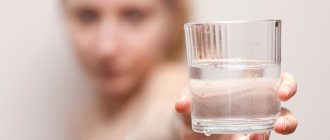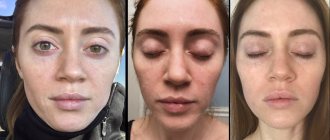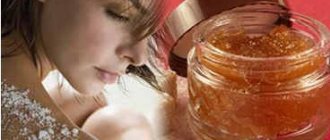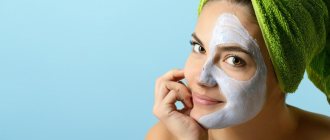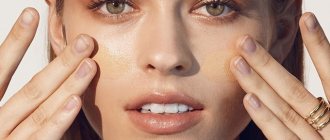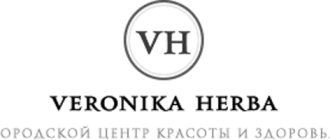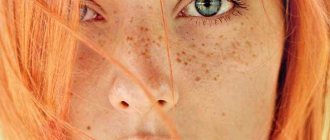Causes of Porous Skin
Sebaceous glands are found on the surface of most of the human skin, with the exception of the surfaces of the feet and palms. The maximum concentration of these glands is observed in the face area; there are also a huge number of them in the area of the scalp, chest and upper back. The sebaceous gland is represented by a secretory section and an excretory duct, the functional activity of which is called the secretion and formation of sebum. Its formation is carried out in cells - sebocytes, which accumulate sebum during maturation. After development is completed, dead cells saturated with fat mass are removed through excretory ducts to the surface of the skin. The secretion of the sebaceous glands is considered to be a special mixture of lipids and moisture, the composition of which will be esters of fatty acids, alcohols, cholesterol and triglycerides.
Controlling the activity of the sebaceous glands is achieved with the help of sex hormones and adrenal steroids. Androgens are male hormones that increase sebum production and estrogens are female sex hormones that reduce sebum production.
Introduction
One of the most common problems in dermatology is oily skin, for which there is always a demand for effective treatment options. This review article focuses on numerous topical treatment options such as retinoids, olemacostat-glosatril, and various cosmeceuticals. Several systemic and procedural methods are also discussed and include isotretinoin, spironolactone, oral contraceptives, botulinum toxin, photodynamic therapy, and lasers. Each treatment option is analyzed in terms of its proposed mechanism of action, effectiveness reported in the literature, and potential side effects. Oily skin is a common dermatological problem that affects a variety of patients, including non-acne patients with enlarged facial pores and greasy skin. . Even a quick search for oily skin care products on Amazon.com offers 9,907 products to treat oily skin. The price range for these products ranges from a few dollars to almost $1,000. One of the more expensive products is marketed as "an anti-aging lotion that combines modern technology with traditional knowledge of healing ingredients for oily or acne-prone skin." Regardless of whether consumers agree with these statements, the need for effective treatment for oily skin remains. Unfortunately, it is difficult to explain why some people suffer from excessive sebum production and others from excessively dry skin. Many factors have been proposed to play a significant role in the pathogenesis of oily skin. This makes creating any one effective treatment challenging. This article reviews the physiology of the sebaceous glands and current and emerging treatment options that can be offered to patients suffering from oily skin. It should be noted that specific generic products are not reviewed individually due to a lack of objective data. Rather, the individual active ingredients are discussed impartially.
Structure and physiology of the sebaceous gland
In addition to the free sebaceous glands on the lips (Fordyce granules), eyelids (meibomian glands), areolas of the mammary glands (Montgomery tubercles), labia minora and foreskin (tysonian glands), the canal of the remaining sebaceous glands connects to the funnel-shaped hair follicle. These glands are highly concentrated behind the ear, on the face, chest and back, which coincides with the location of acne. The main cells containing the sebaceous glands are sebocytes, the breakdown of which releases sebum according to the type of holocrylic secretion. Tallow is a viscous liquid consisting of squalene, wax esters, triglycerides, free fatty acids, cholesterol esters and free sterols. The amount of sebum a person produces varies throughout their life. Sebaceous glands are present at birth, when there is already a relatively high production of sebum. Shortly after birth, sebum production decreases until puberty, when it increases sharply again. Subsequently, sebum production does not decrease until the onset of menopause in women and until the sixth or seventh decade in men. Androgens, especially 5α-dihydrotestosterone, play an important role in the differentiation and proliferation of the sebaceous glands, as well as in the production of sebum. The average rate of sebum production in adults is 1 mg/10 cm2 every three hours. When the level of sebum production decreases to less than 0.5 mg/10 cm2 every three hours, patients show signs of xerosis or dry skin. Conversely, when sebum production exceeds 1.5 mg/10 cm2 every three hours, it is regarded as excessive and leads to seborrhea or oily skin. The rate of sebum production varies greatly between individuals, and the explanation for why this occurs remains to be seen. Several factors have been described and can be used to explain to some patients why their skin may be oilier than others (Table 1). Men have higher sebum production due to higher testosterone levels, although production sebum increases during ovulation in women, which is likely secondary to increased progesterone. Sebum production also varies depending on the environment and time of year. Several studies have described an increase in sebum production during spring and summer and in wetter climates. Overall, in terms of race, Chinese women have noticeably smaller pore sizes and lower sebaceous gland density, while black women have larger pore sizes, which explains their higher rates of sebum production.
Table 1. Risk factors for oily skin
| Male |
| Premenopausal women during ovulation |
| Spring and summer seasons |
| Humid climate |
| African American |
| Conditions of hyperandrogenism (congenital adrenal hyperplasia, androgen secreting tumors of the ovaries or adrenal glands) |
Topicals for oily skin
Retinoids. Topical retinoids contain vitamin A (retinol), its natural derivatives such as retinaldehyde, retinoic acid and retinyl esters, or synthetic vitamin A derivatives such as adapalene and tazarotene. Their effects on the skin are mediated by their interaction with specific nucleic acid receptors. In human skin, the retinoic acid receptor (RAR) family consists of three forms: RAR-a, RAR-β and RAR-γ. RAR receptors interact with the retinoid X receptor (RXR) to form heterodimers. RAR-γ constitutes approximately 90% of the RARs in the epidermis, and RXR-a constitutes approximately 90% of the RXR. Thus, human skin is primarily regulated by paired heterodimers consisting of RAR-γ and RXR-a. These heterodimers continue to bind to a specific region in deoxyribonucleic acid (DNA) known as retinoic acid response elements (RAREs). Upon binding, transcription of genes encoding proteins necessary for the restoration of photomemorable skin, growth and differentiation of keratinocytes, anti-inflammatory effects and suppression of sebum production occurs. Already in the 1970s, reports of the use of topical retinoids for various skin conditions, especially acne, began to appear more frequently. Although the role of retinoids in the growth and differentiation of keratinocytes has been widely recognized for several decades, their influence on the biological function of sebocytes continues to be studied. Retinoid receptors such as RAR-a, RAR-γ and RXR-a, β and γ have been identified in human sebocytes. In vitro, retinoids significantly reduce the proliferation and differentiation of sebocytes and the synthesis of sebum. In vivo studies and clinical experience with topical retinoids have shown their ability to cause dry skin, but there is no direct evidence of a reduction in sebum production. Dry skin is hypothesized to result from normalization of keratinocyte differentiation and proliferation and decreased adhesion of keratinocytes to each other, leading to the formation of flaky skin. skin. It can also be hypothesized that retinoids also bind to retinoid receptors on sebocytes, resulting in decreased sebum production. Both tazarotene and tretinoin have been reported to reduce facial pore size. This is important because larger pores have a direct connection with increased sebum production. Kang et al reported that 42% of patients treated with tazarotene once daily for 24 weeks achieved pore size reduction on a scale of 5. This is significant compared to a 20% reduction in pore size in patients receiving a placebo. Another study found a significant reduction in pore size using a dermoscopic analyzer after 60 women used thyretinoin 0.025% cream once daily for 90 days. The above evidence and discussion make topical retinoids viable for treating oily skin.
Olumacostat glasaretil (DRM01). Dermira. The biopharmaceutical company recently published encouraging data from a phase 2b study conducted for the topical sebum inhibitor, olumacostat glasaretil (OG, formerly DRM01). This new small molecule functions by inhibiting acetyl coenzyme A carboxylase in sebocytes. This enzyme catalyzes the first stage of fatty acid synthesis. In addition, in animal studies, the topical drug Dermira gradually reduced the size of the sebaceous glands. Although this molecule was "designed to inhibit sebum production when applied topically," it was able to reduce the incidence of inflammatory and non-inflammatory acne after a 12-week course. Dermira is reported to be well tolerated with no serious treatment-related side effects and can be used as a topical treatment for oily skin
Cosmeceuticals. Numerous cosmetic products and ingredients are suggested for use in reducing oily skin, but only evidence-based research will be reviewed in this discussion. Draelos et al conducted a double-blind, placebo-controlled study of topical niacinamide 2% significantly reducing sebum excretion levels after 2 and 4 weeks of use. Although topical niacinamide may be beneficial for people with oily skin, further research is needed to explore the mechanism of action and develop the optimal treatment regimen.
Green tea is another cosmeceutical ingredient with some evidence of use for oily skin. In one small study, 10 patients used a 3% green tea emulsion for 8 weeks. When assessing facial skin using a sebemeter (a non-invasive photometric device), there was a significant reduction in sebum production compared to baseline. A slightly larger study with 22 participants also found a significant reduction in sebum secretion after 60 days of using a topical green tea emulsion. Topical cosmeceuticals containing green tea may be beneficial for patients with oily skin.
L-carnitine is also becoming increasingly popular in discussions of potential ingredients that can reduce the appearance of oily skin. Naturally produced in the body, L-carnitine is capable of increasing β-oxidation, the catabolic process by which fatty acids are broken down. Topical 2% L-carnitine has been shown to significantly reduce intracellular fatty acids in human sebocytes and lead to a significant reduction in sebum. Although further research is needed to evaluate the effectiveness of L-carnitine's sebum suppressive properties, it is justified to recommend it to patients with oily skin.
Systemic preparations for oily skin
Isotretinoin. Also known as 13-cis-retinoic acid, isotretinoin is an oral retinoid that has been proven to produce the greatest reduction in sebum of any other treatment option mentioned. As described above, when considering topical retinoids, 13-cis-retinoic acid has also been shown to be able to reduce the size and secretion of sebaceous glands. During oral isotretinoin therapy, sebum production is reduced by 90%, making the drug effective even in patients with severe seborrhea. One year after completion of isotretinoin therapy, the amount of sebum excretion was found to remain significantly suppressed in most people. A lower dose of isotretinoin (<0.5 mg/kg/day) is often used in the treatment of oily skin alone without nodulocystic acne, but this lower dose is clearly associated with a higher recurrence rate. Overall, up to 17% of patients require repeat courses of oral isotretinoin despite achieving the recommended cumulative dose of 120 to 150 mg/kg. Regardless of the severity of oily skin, all patients should be reminded that significantly reducing sebum production does not come without side effects. Most often, patients will experience generalized dry skin, dry and cracked lips, xerophthalmia, and secondary skin infections. Clinicians should educate their patients and provide advice to minimize these common side effects. One of the main side effects that the patient should be informed about before starting oral isotretinoin is teratogenicity, the risk of which cannot be excluded even at low doses. To avoid this risk, sexually active women should use two forms of contraception and undergo pregnancy testing at the beginning and one month before ending therapy.
Spironolactone. Although this potassium-sparing diuretic has been classically used medically as an antihypertensive agent, it is increasingly used by dermatologists to treat oily skin, acne, hirsutism, and androgenetic alopecia in women. Spironolactone has been shown to directly reduce sebum production at dosages of 50 to 200 mg per day. In addition to being an alderosterone antagonist, spironolactone also functions as an androgen receptor blocker and a 5a-reductase inhibitor. Human sebocytes contain 5a-reductase type 1, which converts testosterone to the powerful androgen 5a-dihydrotestosterone (DHT). This androgen plays an important role in inducing sebocyte proliferation. Thus, by inhibiting DHT production and blocking testosterone and DHT from binding to sebocytes, spironolactone has been shown to inhibit sebocyte proliferation in a dose-dependent manner. Before prescribing spironolactone to a patient with oily skin, it is necessary to consider its side effects. The eight-year study reported no serious ongoing or long-term complications associated with spironolactone in the treatment of acne. However, minor side effects were reported in 59% of subjects, with menstrual irregularities among the most common. Hyperkalemia was frequently observed. However, a retrospective study of 974 healthy women taking spironolactone for acne found that hyperkalemia was reported in only 0.72% of analyzes compared with 0.76% of controls. Given these results and other similar reports, many dermatologists consider routine potassium monitoring unnecessary for healthy women taking spironolactone, but ultimately laboratory monitoring remains at the discretion of the individual physician. Given that spironolactone has endocrine effects, it is likely that it may increase the risk of developing hormone-dependent cancers such as breast, ovarian or endometrial cancer. Contrary to this notion, a large cohort of more than 74,000 patients treated with spironolactone showed no evidence of an increased risk of breast, ovarian, or endometrial cancer. These results were confirmed by a number of other recent studies that examined the potential relationship between spironolactone and the risk of hormone-related cancers. Overall, spironolactone is a safe systemic drug for healthy women seeking treatment for oily skin.
Oral contraceptives. Oral contraceptives are beneficial for oily skin because they lead to a decrease in ovarian and adrenal hormones and increase sex hormone-binding globulin, which limits free testosterone. As described above, androgens stimulate the proliferation of sebocytes and promote seborrhea. Estrogens have been found to have an inhibitory effect on sebaceous gland overactivity in vivo. In order to avoid the risk of endometrial hyperplasia, or even cancer, which may result from estrogens, they must be used in combination with a progestin. It is important to consider which progestin is in combined oral contraceptives, as some progestins have their own androgenic activity. Levonorgestrel, desogestrel, norgestimate and norethindrone have the lowest androgenic activity. Some newer progestins, such as drospirenone or cyproterone acetate, are even androgen receptor antagonists and exhibit antiandrogenic properties. Several studies have shown that oral contraceptives actually reduce facial oiliness. In a double-blind, randomized study of 128 women receiving either the ethinyl estradiol/drospirenone combination or the ethinyl estradiol/cyproterone acetate combination, both drugs significantly reduced sebum production. Katz et al found a 60% relative reduction in cheek sebum production and a relative reduction in forehead sebum production in 41 women after six cycles of the ethinyl estradiol/desogestrel combination. Using this same combination of oral contraceptives has also been shown to improve oily skin after just one cycle of treatment. Before starting an oral contraceptive, be aware of the potential increased risk of venous thromboembolism. Newer oral contraceptives have reduced the dose of estrogen in an attempt to eliminate this risk. Some of the most common side effects of oral contraceptives include nausea, breast softening, and menstrual irregularities. Using a combination of oral contraceptives that contains the lowest dose of each hormone can limit or even prevent these common side effects while maintaining improved facial skin.
Other treatments for oily skin
Botulinum toxin. Over the past few years, several studies have evaluated the effectiveness of botulinum toxin for the treatment of oily skin with promising results. One of the first reports in the literature regarding the effectiveness of botulinum toxin for oily skin appeared in 2008 .
A retrospective study was conducted in which 20 patients with oily skin and large pores were evaluated after intradermal botulinum toxin A in the T-zones. One month after treatment, 17 of 20 patients had a photographic improvement in oily skin and a reduction in pore size, and also reported a subjective decrease in sebum production . Li et al later performed a double-blind, split-face study in 20 individuals and found a marked reduction in sebum production on the botulinum toxin-treated side. Another significant prospective study evaluated 25 patients with oily skin who received intradermal injections of botulinum toxin into the frontal area and showed significantly lower sebum production. Additionally, 91% of subjects were satisfied with intradermal botulinum toxin as a treatment for their oily skin. The mechanism of action of botulinum toxin is its ability to cleave proteins involved in the fusion of vesicles with the plasma membrane of the axon terminal of the presynaptic neuron. These vesicles contain acetylcholine, and botulinum toxin blocks the release of this neurotransmitter into the synaptic cleft, where it normally binds to the muscarinic receptor in the postsynaptic cell. In the sebaceous glands, both immature and mature sebocytes have muscarinic acetylcholine receptors, which are important for sebocyte differentiation and skin production lard Considering the evidence and mechanism of action, intradermal botulinum toxin may be a promising treatment option for oily skin.
Photodynamic therapy. Photodynamic therapy (PDT) following δ-aminolevulinic acid (ALA) is used by some to treat acne. ALA is preferentially absorbed by hair follicles, and sebocytes metabolize ALA to photosensitive protoporphyrin IX (PplX). When exposed to light, cytotoxic free radicals are formed, which lead to cell destruction and apoptosis of sebocytes. Despite extensive evidence showing improvement in acne, several studies have failed to demonstrate a significant reduction in sebum production after PDT with ALA. However, one study found that lower sebum excretion persisted even 20 weeks after multiple PDT sessions, but not after a single PDT session. Histological evaluation after PDT revealed destruction of sebocytes and revealed smaller sebaceous glands at 20 weeks. PDT can be a valuable tool to offer to patients with oily skin.
Lasers. There are many different lasers on the market that may be suitable for patients with oily skin. For this purpose, the 1450 nm diode laser is one of the most widely studied lasers. Perez-Maldonado et al observed an 18 percent reduction in total sebum collected six weeks after three 1450 nm diode laser treatments. Another study found a significant reduction in sebum production in 26% of patients after 4 facial treatments using a 1450 nm diode laser. On the other hand, Lauby et al reported that 3 treatments with a 1450 nm diode laser did not lead to significant changes in sebum excretion. Diode laser is not the most effective of the treatment options reviewed, but it still offers a unique treatment option for eliminating oily skin.
Conclusion
Oily skin is a common complaint among dermatological patients. While the sebaceous glands play an integral role in the skin, they create problems in some patients when they are over-functioning. Numerous treatments exist to reduce sebum production, but a clear consensus on the preferred treatment regimen has not yet been described. Each treatment option has its own inherent advantages and disadvantages that should be discussed with patients as a whole, and treatment can be personalized for each patient. We hope that as knowledge about the complex pathogenesis of oily skin increases, newer and targeted treatments will be developed to more optimally treat oily skin.
Characteristics of porous skin
Three processes are considered to be the main problems of porous skin:
- Hyperproduction of sebum;
- Hyperplasia of cells that secrete sebum;
- Follicular hyperkeratosis is a thickening of the area of the excretory ducts of the sebaceous glands.
Porous facial skin is characterized by shortcomings that are inherent in oily and combination skin types. Failure to take proper care of such skin can lead to roughness and looseness of the epithelium; it is distinguished by its relief, glossy appearance and dull tint. Porous skin is prone to the formation of acne, comedones, sebaceous plugs, post-acne and various skin rashes.
Loss of skin elasticity causes pores to enlarge, resulting in skin signs such as photoaging and sagging, which make enlarged pores appear larger. Sebum in men is characterized by a high level of density, so enlarged pores on a man's face appear deeper and more extensive than in women. Large pores that stand out look repulsive when they are clogged with sebaceous plugs or dirt. Decorative cosmetics apply extremely unsuccessfully to porous skin, thereby emphasizing its shortcomings, in particular texture and large pores.
How to remove sagging skin?
When the body is imperfect, it can be hidden under clothes, but with the face this will not work. You will not be able to hide sagging skin on your face. And this already affects the opinion of you, because your appearance deteriorates. In addition, flabbiness adds years. Hair and makeup can be beautiful. But if the facial skin is sagging, then this immediately changes the opinion of a woman; it does not look aesthetically pleasing.
There are certain rules that you should follow if you have loose skin on your face and you want to remove it. We are talking about the chin, neck, cheeks:
- the skin should always be moisturized. Here you need to follow a drinking regime, use masks and creams;
- Use a low pillow to sleep and watch your posture all the time. The back should be straight;
- Perform facial gymnastics regularly. Raise your chin, stretch your lips to the maximum, and then pull them forward. It feels like we want to say the letter “y”.
These recommendations are quite simple and there is no difficulty in implementing them. In addition, it will not take much time and effort.
Features of porous skin care
Porous skin brings certain difficulties to its owner and needs a lot of attention, especially since home care alone may not be enough. Before carrying out caring procedures, it is necessary to visit a dermatologist and cosmetologist to diagnose and examine the skin condition. Experts will evaluate its moisture, oil content, elasticity and determine the presence of skin problems. In some situations, you may need to consult with specialized specialists (endocrinologist, gastroenterologist), as well as additional studies and tests to exclude or confirm the presence of pathologies of internal organs and systems.
Help from a cosmetologist
It is possible to remove a problem such as sagging facial skin, but for this you need to provide an integrated approach. If you have eliminated the cause of sagging, then now you should think about giving up bad habits, eating balanced food, and proper physical activity. All these points are very important for restoring the condition of the skin. These principles are considered important to maintain elastic, healthy skin.
Every woman performs some kind of cosmetic procedure to improve her facial skin. This can be done in any salon. Flabby facial skin and how to deal with it? Experts suggest carrying out the following procedures in case of sagging skin:
- laser therapy. Here defects are eliminated and the skin is rejuvenated. All this is done using a laser;
- photorejuvenation. The skin is exposed to pulses of light;
- peeling. Those cells that are already dead are removed;
- mesotherapy. Substances that are biologically active are injected under the skin;
- biorevitalization. Here injections are made, during which hyaluronic acid is injected under the skin.
If you use one of the above procedures, you can achieve the desired result quite quickly and remove sagging skin. However, there is a common drawback - such procedures are quite expensive.
Mandatory daily care procedures
Caring for porous facial skin every day consists of cleansing, toning and moisturizing it with the help of cosmetics that are suitable for the patient’s skin type. When caring for such skin, you should not use greasy products or apply thick makeup. Washing porous skin with hot water and soap, applying alcohol products, as well as aggressive cleansing can only worsen existing difficulties with the facial skin, which destroy the oil-water balance, thereby dissolving the skin membrane, consisting of water and lipids.
The following procedures will help normalize the level of sebum secretion:
- rinsing with warm or cool water;
- the use of products that lead to narrowing of pores;
- rubbing the face with cosmetic ice with herbal extracts.
Eliminating contamination from pores and removing the stratum corneum requires performing procedures such as peeling, gommage or scrub twice a week, as well as the use of cleansing strips. Masks based on white clay also adsorb excess sebum well and tighten pores. After toning and cleansing the skin, a cream with moisturizing properties is applied.
Makeup rules
Those with porous skin should take a thoughtful approach to applying makeup. It is advisable to do without it; if decorative cosmetics are necessary, they must be applied correctly. Most women use a large amount of foundation to disguise porous skin. This should not be done, otherwise the flaws will become more noticeable, and cosmetics will clog the pores even more.
Makeup should be applied to a thoroughly cleansed face rubbed with an ice cube. Under the influence of cold, the tubules will narrow, and particles of cosmetics will not get into them.
You should apply a moisturizer underneath your decorative cosmetics to make your skin look smoother. The foundation should be light; under a thick one (with a matte effect), the skin will begin to sweat. You can use powder for oily problematic porous skin. A product with a light reflection effect is best suited; it will distract attention from defects. The emphasis should be on the eyes, not on the cheekbones.
Before going to bed, your face should be thoroughly cleansed of makeup using micellar water or toner.
Cosmetology procedures
Treatment of porous skin using a cosmetic method involves performing procedures such as:
- Facial cleansing: considered the main procedure to solve the difficulties of enlarged pores;
- Peeling (enzyme and glycolic);
- Laser skin resurfacing: aimed at renewing the epidermal layer of the skin, eliminating post-acne marks and reducing pores;
- Microdermabrasion: in terms of its effectiveness, this procedure is equal to gas-liquid peeling and is considered less aggressive in comparison with laser resurfacing.
Additional procedures for caring for porous facial skin will include the use of facial massage, darsonvalization, ultraphonophoresis, alginate masks, as well as mesotherapy using individual compositions.
Treatment of porous facial skin also involves the use of a special therapeutic massage, which is performed between facial cleansing procedures. It helps eliminate sebum from the ducts and, if used systematically, will significantly reduce the size of pores. Manual massage affects all levels of the skin - subcutaneous fat, dermis, muscles and blood vessels, and is also characterized by a drainage effect, which promotes cell renewal and improved blood flow.
Products for narrowing pores
As already mentioned, the choice of products for narrowing pores in pharmacies is quite large. You can consult a doctor and choose the right one for your particular case, or you can prepare the necessary drug at home.
Lemon and cucumber lotion
Cucumber-lemon lotion is effective against porous skin problems caused by excessive oiliness.
Prepare the product in the following way:
- Mix 4 tbsp. finely grated cucumber with 1 tbsp. crushed lemon peel.
- Add 2 tbsp. lemon juice.
- Pour 200 g of alcohol into the resulting mixture.
- Leave for 20 days.
- Strain.
- Dilute slightly with mineral water (or boiled water).
- Add egg white and 1 tsp. honey
You should wipe your face with the resulting lotion twice a day.
Potato compress
Compresses for enlarged pores have a cleansing and steaming effect. You can carry out the procedure using regular potatoes.
To do this, you need to take a raw root vegetable, grate it on a fine grater, wrap it in gauze, and apply it to your face. A similar manipulation can be done by dipping cotton swabs in squeezed potato juice and applying them to problem areas.
The duration of the procedure is 15-20 minutes.
Ice compress
Cold water itself causes the pores to narrow; ice is even more effective in this situation. Cubes for cold treatment at home are made from mineral water, juice or herbal infusion.
The following plants are suitable:
- chamomile;
- calendula;
- sage;
- linden flowers.
2 tablespoons of any herb (you can use a mixture) pour 200 g of boiling water. Let it brew for 40 minutes, strain, pour into molds, and put in the freezer. Morning and evening, wipe your face with cubes.
Frozen lemon juice diluted with water in a ratio of 1:2 perfectly tightens pores.
Camphor compress and jojoba oil
Camphor and jojoba oils have a lot of beneficial properties for the skin and are actively used in cosmetology to solve the problems of oily skin with enlarged pores.
You can prepare a composition for compresses with these components in several ways:
- prepare cotton weaving with slits for eyes and lips. Mix a tablespoon of milk thistle oil with the same amount of grape seed oil. Add 5 drops of camphor and a couple of drops of jojoba oil. Mix thoroughly, saturate a fabric mask with the composition, and keep on your face for 30 minutes. Remove residues by blotting with a napkin;
- dilute two crushed tablets of white coal with water to a paste, pour in 5 drops of camphor, 15 drops of jojoba oil. Apply the mixture to the face along the massage lines, and rinse after seven minutes. Then treat the skin with an antiseptic;
- Add oatmeal (2 tbsp) to the beaten egg white with 10 drops of lemon juice and mix with camphor and jojoba oils (a couple of drops of each). Leave on your face for a quarter of an hour, rinse with water at room temperature.
The products can also be added to any daily care cream. They are relatively safe, but are strong allergens. If there is the slightest sign of irritation after using oils, their use should be stopped immediately.
Contraindications for treating porous skin with camphor:
- liver pathologies;
- dermatitis;
- microtraumas at the site of application of the product;
- epilepsy;
- eczema;
- under two years of age.
Camphor is prohibited for oral administration!
During pregnancy and breastfeeding, the product can only be used after prior consultation with a doctor.
Viburnum mask
Viburnum is actively used in cosmetology due to the content of the berries:
- vitamins A, E;
- acids;
- pectin;
- minerals;
- tannins.
Hardware techniques
In parallel with massage, to improve the drainage effect, hardware techniques are used, in this case it is pneumophototherapy, which consists of phototherapy and vacuum massage. The vacuum pulls the secretion of the sebaceous glands to the surface, facilitating its removal, and the action of phototherapy provides a sebostatic and antibacterial effect. After using pneumophototherapy, redness, which is caused by disruption and stagnation of microcirculation, disappears, the skin tightens and evens out in color.
The success and effectiveness of treating porous skin depends on a comprehensive combination of salon treatments and proper care at home.
Recipes for healing masks
It is recommended to do masks for porous facial skin three times a week. You should first thoroughly wash off your makeup and steam the upper layer of the dermis - this will ensure deeper penetration of the active ingredients. Before carrying out the manipulation, you must make sure that you are not allergic to the selected medicinal composition.
You need to leave the mask on your face for a certain time and remove its remnants. Treat porous skin with moisturizer.
For the procedure, you can use a product purchased in a store or try to cope with the problem with masks prepared at home. Here are some popular recipes.
Egg and lemon
Beat the white of one egg into a foam, mix evenly with lemon zest (you can replace it with a few drops of the juice of this fruit), apply to your face. Wait until the composition “sets” into a crust, remove the residue.
This mask helps:
- tighten pores;
- remove oily shine;
- get rid of blackheads;
- whiten skin.
To give your face freshness, you can add an ampoule of glycerin to the listed ingredients.
Cucumber and egg
To prepare such a mask, you need to mix cucumber pulp with egg whites beaten until foamy. Apply to problem areas. Remove any residue after the mixture has dried.
Thanks to cucumber, the skin is moisturized and becomes fresher. Protein – cleanses pores. You can add half a spoonful of honey to the mixture.
Gelatin and milk
To obtain a medicinal mixture for porous skin you need:
- Crush the activated carbon tablet.
- Mix with one tablespoon of gelatin.
- Add 2 tablespoons of milk.
- Microwave for 20 seconds.
- Apply to face.
- Remove the film formed after drying.
After the procedure, the skin may turn red - this is normal. You should wipe your face with a piece of ice.
Clay mask
Cosmetic clay is an excellent natural absorbent. It is used to treat many dermatological problems, including helping to tighten pores.
The product must be diluted with water to a paste. Apply a thin layer, leave for a quarter of an hour, then rinse thoroughly.
3. Symptoms and diagnosis
The concept of skin laxity is associated with insufficient elasticity, the presence of sagging folds, porosity and “cellulite” looseness, and a dull yellowish color.
The simplest diagnostic method is the so-called. “Pinch test”: the skin of the face or hand, gathered into a fold with your fingers, should be smoothed out as quickly as possible without a trace.
However, it must be repeated: if the sight of your own skin in the mirror causes dissatisfaction or even stronger negative emotions, you should not start with a trip to a beauty salon or with a wholesale purchase of expensive products.
An experienced aesthetic medicine doctor will ask many questions regarding individual and family history, general well-being and lifestyle, past and chronic diseases, profession, etc. One or another examination will be prescribed, the results of which may first of all require treatment from specialists of a completely different profile.
About our clinic Chistye Prudy metro station Medintercom page!
